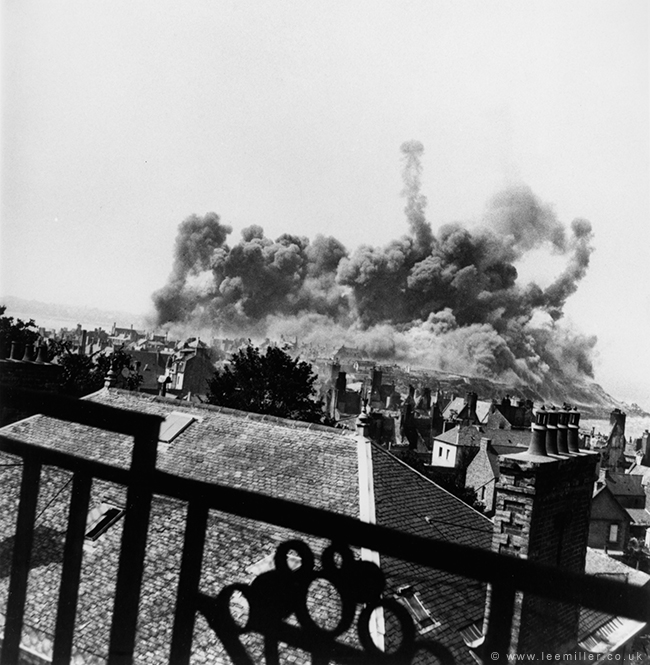Who was Lee Miller?

Born in Poughkeepsie, New York in 1907, Lee Miller was an amazing woman who led an incredible life, then drifted into obscurity: a 1920’s supermodel, she gave it up to go to Paris and work with Man Ray, becoming a surrealist photographer in her own right. Returning to New York to set up a studio, she was soon in great demand for portrait and fashion photography. After a period in Egypt she became a freelance photographer for British Vogue as World War 2 broke out, photographing the bombing of London known as the Blitz. In 1944 she became a combat correspondent for the US Army, accompanying the troops into Europe – one of the first female war photographers. She photographed conflict extensively, including the grim Siege of St Malo in August 1944 and the Liberation of Paris, and was among the first to take pictures of Nazi concentration camps and their victims. Reaching Adolf Hitler’s house in Munich with US forces, she promptly took a bath in his bathroom!
After the war she married Roland Penrose, an English painter, and moved to Farley Farm House in the Sussex countryside, where she photographed artists who were friends, including Picasso, Miró and others, continuing to work almost up to her death in 1977.
Lee Miller was deeply traumatised by the horrific events she had witnessed. Her son and biographer, Antony Penrose, says, “She had what we would now call PTSD”. She buried her collection of prints and negatives in the attic. She wanted to forget all about them. Her life and career disappeared down the “Memory Hole”.
Antony’s wife Suzanna was going through her things after her death and was astonished to find an enormous cache of photographs in cardboard boxes. Tony says, “We found this amazing collection of images going back to her early years in Paris in 1929, reaching practically to the end of her life. We didn’t have a clue what to do with them. I was a dairy farmer and my wife was a ballet teacher – although we had a love of art and photography, neither of knew anything about the commercial side of the media. Thanks to the advice of the then Curator of Photography at the V & A Museum, Mark Haworth-Booth, we enlisted Valerie Lloyd, a young curator, to survey and catalogue the material, which amounted to 60,000 negatives and 20,000 original prints as well as diaries and manuscripts.”

RESERVED. WWW.LEEMILLER.CO.UK
After that they were faced with the dilemma – what to do with it. If they gave it to a museum it would just sit in a basement, probably unseen by anyone, except the most diligent researcher.
“By this time both of us had fallen in love with the images.”
They wondered about setting up a photo-agency and were told that if they succeeded commercially, they would be the first artist’s estate to do so! Somehow a publisher heard they had some pictures of Picasso, sent a car round immediately, published them, and paid for them.
Tony says, “I thought, bloody hell, there is some hope!”
They decided to continue, with the aid of the British Association of Picture Libraries and Agencies (BAPLA), and in particular Sal and Brian Shuel, who supported them as they ventured into the unknown territory. “They were absolutely brilliant, they held our hands, they gave us the loan forms, showed us the procedures, gave us an idea what to charge, we couldn’t have done it without them.”
He wrote “The Lives of Lee Miller”, which came out in 1985 and coincided with their first major exhibition, at The Photographers’ Gallery in London. It was very hard to establish themselves but the images gradually reached an audience.
Now the agency employs ten staff, and became profitable ten years ago. The pictures are held in a climate-controlled vault which was specially built to contain the archive. The picture agency is the backbone of their income, while they intermittently create large exhibitions of Lee Miller’s work. Tony was slightly coy about forthcoming projects but hinted that they were working on a big exhibition which would tour the US in the future. He says the worst problem they face is pirating of their images.
The collection is not static as recently they have started adding other photographers connected to the era and subject matter that Lee Miller photographed, including the estate of Life photographer (and friend of Lee’s) David E. Scherman, and Andrew Lanyon, who photographed artists like Miró and Man Ray when they visited the farm.
For real fans of her life and work, Farley Farm House is open to visitors for tours on Sundays in the summer months, who can see the fabulous collection of art built up by Lee Miller and Roland Penrose, including Picasso, Man Ray and Max Ernst.
Tony says, “It is very rewarding to see how many admirers, particularly young women, are inspired by her work, they dump dull careers, dull relationships, and become these forward-moving women photographers. I love it!” He finished, laughing.
Lee Miller Archives:www.leemiller.co.uk
All images © 2016 Lee Miller Archives, England. All rights reserved. www.Leemiller.co.uk

 Julian Jackson is a writer with extensive experience of picture research, whose main interests include photography and the environment. His portfolio is at:
Julian Jackson is a writer with extensive experience of picture research, whose main interests include photography and the environment. His portfolio is at: